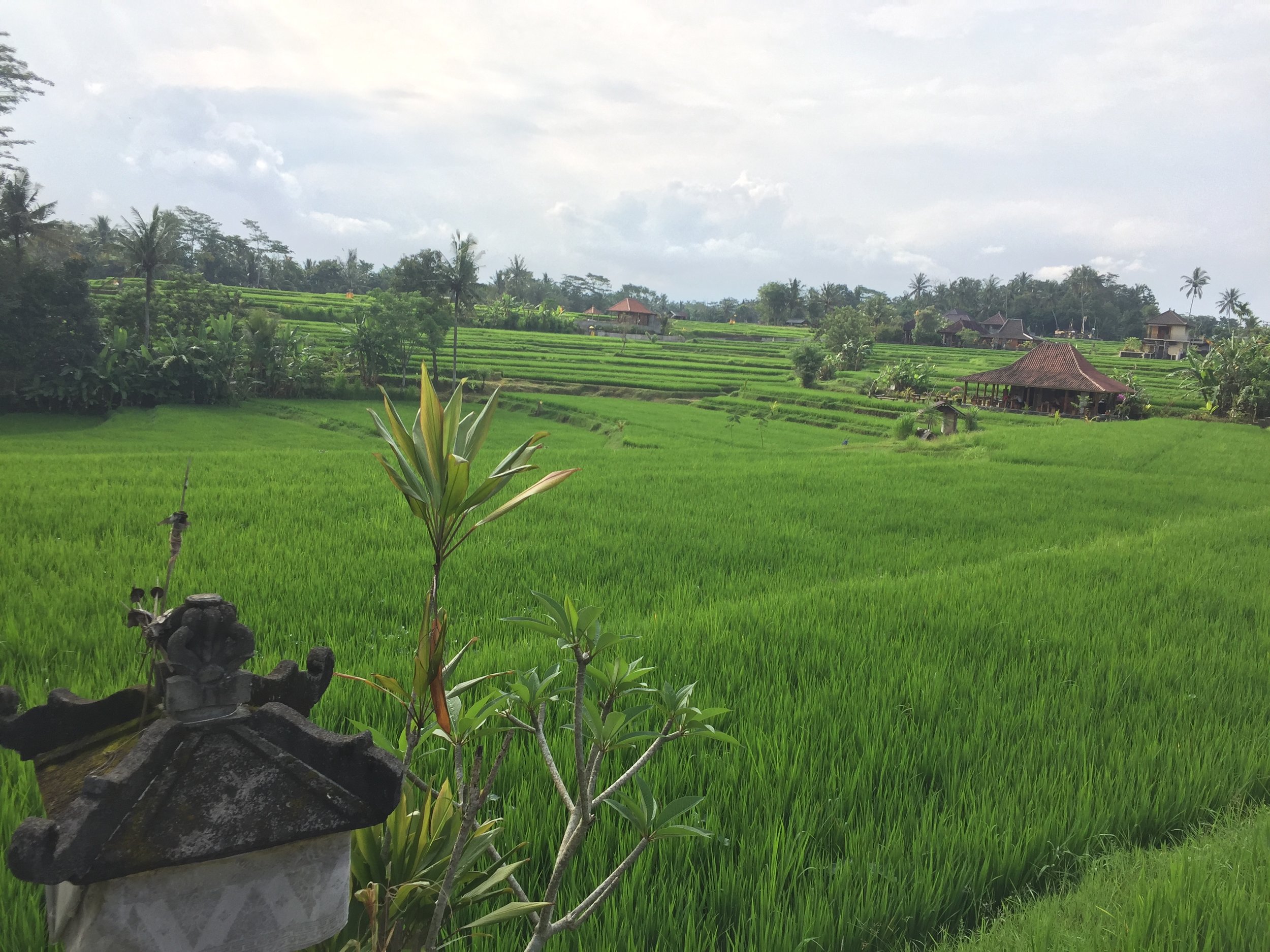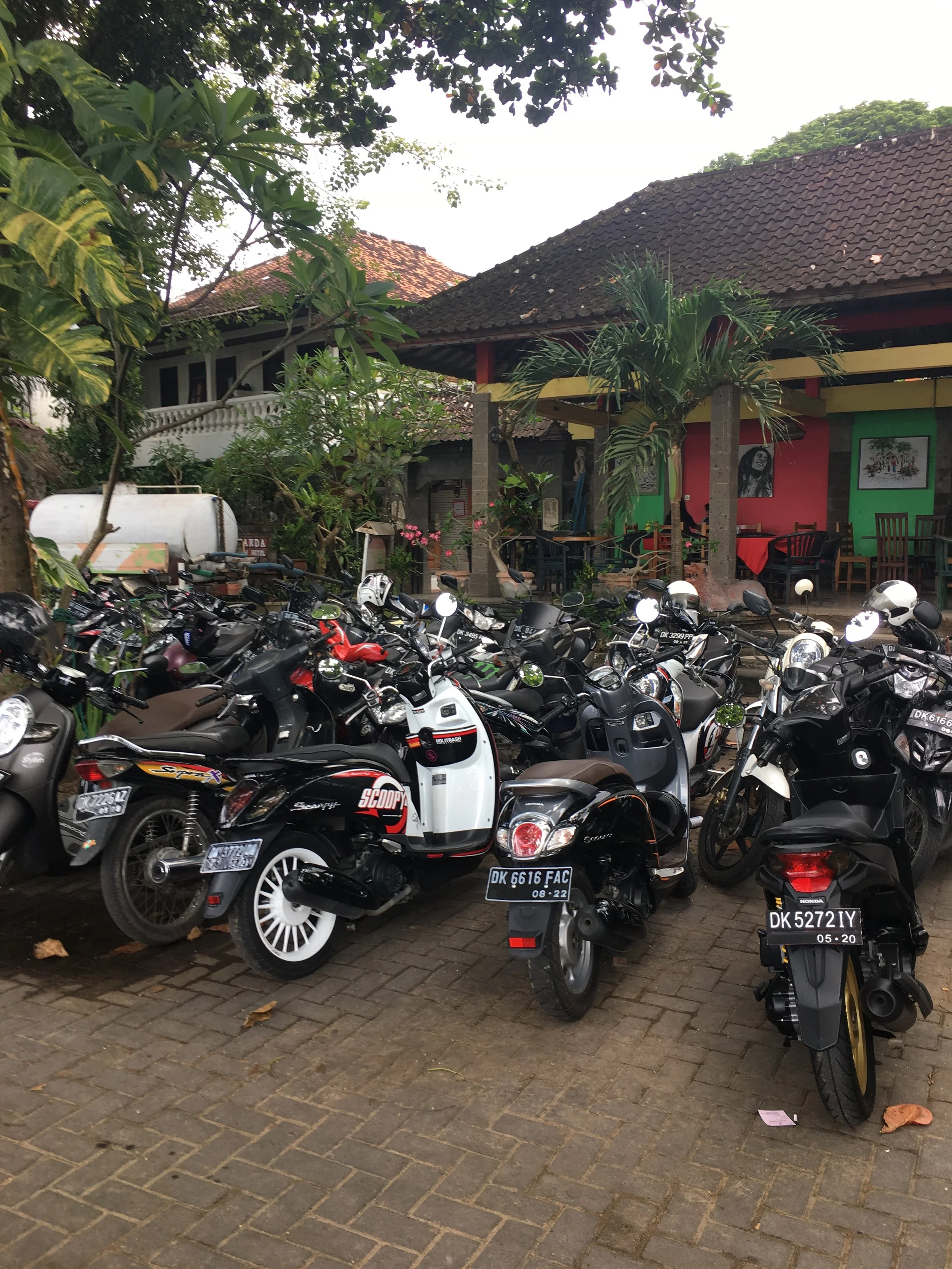Ubud: Never Wanna Leave
Ubud is a magical place. It's lush and spiritual and vibrant. I remember bits and pieces of Ubud from visiting in 2011, but the prevailing memory was that I loved it. It wasn't a particular site, but rather, the overall essence of the various small villages that comprise Ubud.
With that in mind, we stayed for an entire week. I had few goals in Ubud, so it was easy to feel fulfilled.
We stayed at the Sapta House, a centrally located homestay in a family's temple.
View from the terrace from our room
Mornings started at our homestay with scrambled eggs or an omelet with a toasted banana sandwich or Nasi Goreng, the unofficial national dish of Indonesia which literally translates to fried rice. Unpictured is the bright tropical fruit that accompanied all breakfasts.
The center of Ubud can get quite congested with traffic and tourists as it's been gaining an explosive popularity. Fortunately, it's easy to quickly escape the chaos.
There isn't a laundry list of must-see highlights, and yet there's plenty to do. We enjoyed the Campuhan Ridge Walk, a paved path in a valley along the rice paddies.
We did the walk a couple times, and found it's best late afternoon, especially around sunset.
The height of the day can get oppressively hot with little shade. Luckily there were plenty of warungs--family owned businesses--along the way to stop for a refreshing smoothie or fresh fruit juice.
Another walk we frequented was through the rice fields towards the infamous Sari Organik farm and restaurant.
We tried not to get jaded by the scenery, as it became more familiar.
We tended to follow the path, but made our own flight plan at times.
The rich shades of green of the rice fields were awe-inspiring.
Although we preferred venturing from the center of the city, there were tranquil places we found by aimlessly wandering the streets. The lotus pond at Saraswati temple in the evening was beautiful.
Or the Royal Palace, which is essentially in the middle of Ubud. The palace was built during the lordship of the late Ida Tjokorda Putu Kandel (1800-1823). Perhaps most remarkable is how the structure and surrounding gardens are preserved.
It wasn't difficult to find temples and appreciate the ancient design and architecture.
When downtown, you're repeatedly asked two questions: "taxi? transport?" and "dance? temple dance?" Since we were staying downtown, we never needed a taxi. However, the requests to drive us were unrelenting, often asking us if we needed transport for the following day or the day after. We did, however, buy tickets for the Kecak Fire and Trance Dance (Rp. 75,000 is roughly $5 UDS).
Traditionally, the dances are during temple ceremonies in Bali and serve as an offering to the Gods and ancestral spirits. The choreographed Sita Haran story was preformed through chanting and dancing by families from a nearby village.
Although in vain, a highlight for us was when the kind white monkey made an appearance in the audience and stopped for a quick pic during the show.
Since we were staying for a week, we created our own daily routines. In Indonesia, you can't drink the tap water, and we've gotten into the habit of using bottled water to brush our teeth. There was a great supermarket nearby, Coco Grocery and Bakery, where we'd buy 1.6 gallons of water in bulk. We also always get a kick out of trying the foreign local snacks. These chocolate brioche-like rolls from the bakery became a quick favorite. It also came with a red bean paste filling, but we stuck to chocolate.
We typically ventured out later in the afternoon when the sun wasn't blazing. We'd bring our journals, Kindles, and a deck of cards to cafes for a break.
The cafe culture in Ubud is extensive. We had a few favorite spots, but you really can't go wrong. We enjoyed The Kafe and Clear Cafe, both around the corner from the Sapta House. And also Taco Casa, for dinner for a change up. When we came across Cafe du Monyet, we stayed a while.
It had a Parisian influence, and moreover, a tranquil view of the rice fields. In Ubud, you can really find anything you're craving.
But it was the hole in the wall Indonesian eateries that were the most memorable, and certainly the most flavorful.
Essentially, Indonesian cooking is a labor of love. It's unfortunate the cuisine doesn't have more of a presence in the States.
An undeniable aspect of Ubud is the yoga scene. It's a yogi haven.
I took several classes at Radiantly Alive. I can honestly say it's the first time I've enjoyed a yoga class. I found one instructor who was fantastic and made the practice accessible. A particularly funky class was sky yoga, using hammocks. Similar to most studios, they offer discounted packages, which I would highly recommend.
There's an easiness to staying in Bali. Perhaps it's the yoga or the slower pace or that the Balinese are the kindest, most genuine people. It's a place where visitors don't want to leave--and for good reason.
It's highly livable, and in fact there are several co-working spaces, which suggests a large expat community. We spent days exploring the streets, following winding alleyways, perusing markets.
There's no denying the massive tourist presence in Ubud. It's lauded as the cultural epicenter of Bali. However, it's easy to detach from the bustle and find serenity in the natural scenery.
Our most gratifying moments were when we got out of town. The people are so warm and genuine, and willing to share glimpses into their daily social lives.
I had high hopes that Ubud would live up to my vague, glorified memories. And it did. Ubud is a place you want to keep returning to, as there's always something new to appreciate, new to learn, new to share.





































